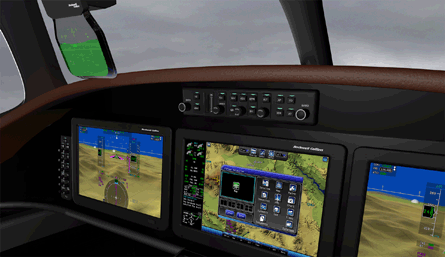Rockwell Collins has leapfrogged the competitors in the Part 23 light jet and turboprop arena - a sector that has increasingly turned to Garmin for leading edge user interface technologies, such as synthetic vision and touch screen controllers.
Rockwell Collins, and its US competitor Honeywell, have traditionally focused on larger Part 25 business jets, while Garmin has garnered market share on the lighter side of general aviation through intuitive interface features - most recently touch screen flight management system controllers.
This is set to change in the fourth quarter of 2013, when the first versions of Rockwell Collins' new Pro Line Fusion system will hit the market in a retrofit application.
The suite, applicable as an upgrade to existing Pro Line 21 flightdecks, will feature three 381mm (15in) touch screen primary and multi-function displays - an industry first.
The synthetic vision-equipped flightdecks are to be supplied to a retrofit application launch customer, who has not yet been announced. No forward-fit contracts have been announced.
 |
|---|
© Rockwell Collins |
Other enhancements or options available with the new Fusion flightdeck include integrated head-up synthetic vision, with Rockwell Collins' new smaller, lighter HGS-3500 head-up display (HUD), MultiScan weather threat detection and full integration with the company's Ascend flight information service.
The system will also include Rockwell Collins' autonomous backup - a one-touch emergency mode that puts the aircraft into a holding pattern at a safe altitude and provides guidance to the nearest airport during engine loss situations.
The new flightdeck is being designed for "head-up, eyes-forward" operations by a single pilot, with software so intuitive that "avionics training is unnecessary and nonexistent", said Adam Evanschwartz, Rockwell Collins' principal marketing manager for product systems. "You touch what you want to change," he added.
Evanschwartz said a flight can be carried out from start to finish completely on-screen, with "drag and drop" options and on-screen rerouting.
A tab cursor device on the centre console, similar to the puck-shaped cursor control devices used in the automotive industry, is also available for interfacing with the system.
Rockwell Collins is also developing iPad applications that, through Ascend, will wirelessly connect with Fusion, allowing pilots to develop flight plans away from the aircraft and have the information automatically uploaded to the flight management system once on board.
Evanschwartz said the company is experimenting with a focus group on pre-flight planning with Ascend, including operations with the iPad.
The market potential must be significant, as the company is building a new manufacturing lab for the product line, with plans for 150 employees.
As of late September, there were 80 employees at work on the project at the company's Cedar Rapids, Iowa headquarters.
The workforce is separate from Rockwell Collins' Part 25 Fusion development programmes - selected for 11 flightdeck projects to date.
Evanschwartz said the customer for the retrofit program will be supplying a flight test aircraft in Cedar Rapids for the programme, and that engineers are already "gearing up" for first flight.
Colin Mahoney, vice-president, sales and marketing for commercial systems at Rockwell Collins, said the company expects "to be a leader" in size, weight and cost for integrated avionics at this end of the market.
"We will be able to go head-to-head with Garmin on price," he said.
Source: Flight International



















